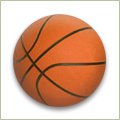 from http://www.technion.ac.%20il/
from http://www.technion.ac.%20il/After a talk I gave to a group of basketball players on their way to an international tournament, a young lady came up to me and asked me if I knew about rhabdomyolysis. She had been diagnosed and treated for it in a hospital and was worried that it might happen again. I told her that, while I was familiar with it, I needed to do a little research first before getting back to her.
Here's what I found:
Exertional rhabdomyolysis is a rare illness that happens when a person has an intense physical activity that breaks down their muscles. While there is always a little muscle breakdown that occurs with heavy exercise, this is much more severe. The muscles cells break apart and the injured muscles release myoglobin, creatine kinase and other muscle cell contents into the blood stream.
Mild and moderate cases can cause high levels of sodium, potassium, phosphorous and calcium in the blood. This can lead to pain and swelling of the muscles, stomachache, nausea and back pain. In more severe cases (very rare), the myoglobin gets into the urine, causing it to become a dark tea or brown color. When the myoglobin is this concentrated, it can injure the kidneys. In fact, if left untreated really severe cases can lead to clots in the blood, kidney failure and even death.
Mild and moderate cases can cause high levels of sodium, potassium, phosphorous and calcium in the blood. This can lead to pain and swelling of the muscles, stomachache, nausea and back pain. In more severe cases (very rare), the myoglobin gets into the urine, causing it to become a dark tea or brown color. When the myoglobin is this concentrated, it can injure the kidneys. In fact, if left untreated really severe cases can lead to clots in the blood, kidney failure and even death.
Now this doesn't happen very often. Most players can push themselves during workouts and games without having to worry about it. But there are some things to avoid if you want to decrease the chance of this happening to you.
Things that INCREASE a person’s risk for exertional rhabdomyolysis/make it MORE likely to happen include:
* high temperatures and humidity levels,
* poor physical conditioning
* not drinking enough fluid
* taking certain medicines like aspirin
* cocaine or alcohol abuse and/or
* recent viral illness (cold, flu).
* Having Sickle cell trait
Things that REDUCE the risk of exertional rhabdomyolysis/ make it LESS likely to happen include:
* Limiting exercise that pushes you to the brink of your ability
* Limiting exercise in higher than average temperatures
* Making sure that you consume enough carbohydrates and that you have sufficient rest periods to enhance the body’s ability to convert the carbohydrate to glycogen
* Keeping well hydrated at all times
If you're a basketball player with a history of kidney disease, heat exhaustion and/or previous case of rhabdomyolysis, you should see a doctor (and get blood and urine testing) if you experience brown discoloration of your urine, have back or stomach pain, or pain and swelling in your legs or arms that comes after a period of high intensity exercise. You might need intravenous (IV) fluids and be admitted to the hospital to make sure you recover well and future exercise might need to be adjusted to keep it from happening again.
* Limiting exercise that pushes you to the brink of your ability
* Limiting exercise in higher than average temperatures
* Making sure that you consume enough carbohydrates and that you have sufficient rest periods to enhance the body’s ability to convert the carbohydrate to glycogen
* Keeping well hydrated at all times
If you're a basketball player with a history of kidney disease, heat exhaustion and/or previous case of rhabdomyolysis, you should see a doctor (and get blood and urine testing) if you experience brown discoloration of your urine, have back or stomach pain, or pain and swelling in your legs or arms that comes after a period of high intensity exercise. You might need intravenous (IV) fluids and be admitted to the hospital to make sure you recover well and future exercise might need to be adjusted to keep it from happening again.
Again, I don't want to keep anyone from playing the game. Just use the recommendations above to reduce your risk, use your common sense and, if you think you might be suffering from this condition, get help from your doctor.













